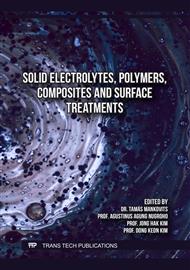p.3
p.15
p.25
p.37
p.45
p.57
p.67
p.75
Degradation of Bioplastic TPS Composite with Natural Fillers
Abstract:
This article investigated the properties and applicability of a composite containing thermoplastic starch (TPS), coffee and straw fiber. Plastics are indispensable in everyday life because these materials are used very widely, e.g. industrial and agricultural use, food packaging, cables, car parts, mattresses, medical devices, household appliances, etc. Although the use of plastics has many advantages, an environmentally conscious approach is increasingly important in modern society and therefore the disadvantageous properties of plastics have also become an issue. On the one hand, they are petroleum derivatives, which are a finite resource, and on the other hand, the life cycle of packaging materials is short. Multiple recycling is also a problem due to the deteriorating quality during recycling. The above two negative properties can be eliminated by using biopolymers, as biopolymers effectively replace single-use petroleum-based packaging products, for which recycling is difficult or impossible from environmental and economic perspectives. The aim of the pilot program was to produce a mixture of biodegradable biopolymers, including starch-based TPS polymers, coffee grounds and straw fiber, and to investigate one of the main indicators of degradable polymer composites, the degradation process by reacting in different pH matrixes (4 different water and 3 different soil-based matrixes) during a period of 0-2 months. The degradation process was analyzed by following mass and shape changes and FT-IR measurements. The applicability of the biopolymer composite was verified, as the decomposition process was proven in an aqueous medium at 72h. We were able to detect the conversion of some chemical bonds through the change of absorbance of carbonyl and CH2 groups, CH3 umbrella vibration. The produced mixture is planned to be used in agricultural areas as a raw material for seedling pots, which could reduce the generation of additional waste and, by using fillers, the use of the composite also provides protection against pests.
Info:
Periodical:
Pages:
3-14
Citation:
Online since:
May 2025
Authors:
Keywords:
Price:
Сopyright:
© 2025 Trans Tech Publications Ltd. All Rights Reserved
Share:
Citation:



